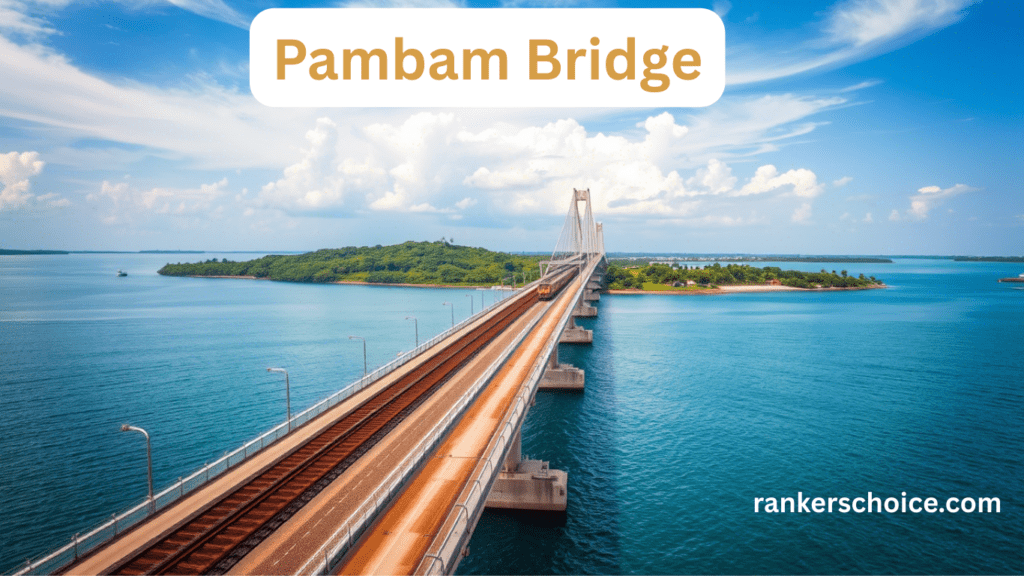
The Pamban Bridge, located in the waters of the Bay of Bengal, is an iconic symbol of India’s engineering prowess and historical legacy. Stretching over 2 kilometers across the Palk Strait, it connects the island town of Rameswaram in Tamil Nadu with the Indian mainland. Recently inaugurated by Prime Minister Narendra Modi, the new Pamban Bridge replaces the century-old structure that had served as a vital link since its construction in 1914. This article delves into the historical significance, technological advancements, and socio-economic impact of this engineering marvel, offering insights relevant for competitive exams such as UPSC, Punjab PCS, and others.
Table of Contents
Historical Background
Geographical Origins
Pamban Island, also known as Rameswaram Island, was once part of the Indian mainland. However, a devastating cyclone in 1480 separated the island from the mainland, creating a narrow channel called the Pamban Channel. Recognizing the strategic importance of connecting Rameswaram, the ruler of Madurai during the Nayak dynasty, Thirumalai Nayak, constructed a causeway across the channel. This early effort laid the foundation for future connectivity.
India’s First Sea Bridge
In the early 20th century, the British colonial government decided to construct India’s first sea bridge to connect Rameswaram with the mainland. Work began in June 1911, and the railway line was officially opened in 1914. Designed by German engineer Scherzer, the original bridge featured a manually operated “rolling lift” mechanism to allow ships to pass through. It played a crucial role in facilitating trade, pilgrimage, and tourism for over a century.
However, tragedy struck on December 22, 1964, when a severe cyclone destroyed a portion of the bridge, washing away a six-coach passenger train. This incident underscored the vulnerabilities of the aging structure, prompting calls for modernization.
The New Pamban Bridge: A Technological Marvel
Key Features
The new Pamban Bridge, inaugurated in 2025, is a state-of-the-art infrastructure project that exemplifies India’s ability to deliver cutting-edge solutions in challenging marine environments. Here are its key features:
- Automated Vertical-Lift Span :
- The bridge features a 72.5-meter vertical-lift span that can rise up to 17 meters , allowing large ships and vessels to pass underneath seamlessly.
- This mechanism is fully automated and controlled by sensors, ensuring precision and safety.
- Corrosion-Resistant Design :
- Constructed using stainless steel reinforcement , high-grade protective paint , and fully welded joints , the bridge is built to withstand the harsh saline conditions of the Bay of Bengal.
- A special anti-corrosion coating protects the structure, ensuring its longevity and durability.
- Dual Rail Tracks :
- The bridge is designed with dual rail tracks to accommodate future demands, enabling faster and heavier trains to operate. This enhances connectivity and meets the growing transportation needs of the region.
- Disaster Resilience :
- Engineered to withstand natural calamities such as cyclones, earthquakes, and tidal waves, the bridge incorporates advanced seismic design features and wind-resistant structures.
- Eco-Friendly Construction :
- The construction process adhered to environmentally sustainable practices, minimizing damage to the fragile marine ecosystem of the Palk Strait.
Cost and Specifications
- Length : 2.08 km
- Spans : 99 spans
- Cost : ₹700 crore
- Vertical-Lift Span Height : 17 meters
Socio-Economic Impact
Boost to Tourism
Rameswaram is one of the Char Dham pilgrimage sites and attracts millions of visitors annually. The improved rail connectivity provided by the new bridge will enhance accessibility, encouraging more tourists to visit this sacred town. This will boost local businesses, create employment opportunities, and contribute to the region’s economic development.
Trade and Commerce
The bridge facilitates seamless transportation of goods between Rameswaram and the mainland, benefiting industries and trade in the region. Enhanced connectivity will also promote cross-border trade with Sri Lanka, given Rameswaram’s proximity to Mannar Island.
Employment Opportunities
The construction and maintenance of the bridge have generated significant employment opportunities for the local population. Additionally, the influx of tourists and traders will further stimulate job creation in sectors such as hospitality, transportation, and retail.
Significance for Competitive Exams
UPSC and State PCS Relevance
- Infrastructure Development :
- The Pamban Bridge is a prime example of India’s focus on modernizing its infrastructure. Questions related to infrastructure projects, their socio-economic impacts, and technological innovations are frequently asked in UPSC and state PCS exams.
- Marine Environment Challenges :
- Understanding the challenges of constructing infrastructure in marine environments, such as corrosion, cyclones, and seismic activity, is crucial for answering geography and environment-related questions.
- Regional Connectivity :
- The bridge highlights the importance of regional connectivity in promoting trade, tourism, and cultural exchange. Such topics often appear in GS Paper II and III of the UPSC exam.
- Historical Context :
- Knowledge of the historical significance of the Pamban Bridge, including its role during the British era and its connection to the Nayak dynasty, is valuable for history and culture-related questions.
- Technological Advancements :
- The vertical-lift mechanism and corrosion-resistant materials used in the bridge showcase India’s technological advancements. Questions on science and technology, particularly in infrastructure, are common in competitive exams.
The new Pamban Bridge is not just a transportation link; it is a symbol of India’s progress in infrastructure development and technological innovation. By combining state-of-the-art engineering with eco-friendly practices, the bridge demonstrates India’s commitment to sustainable growth and regional development. As a vital artery connecting Rameswaram to the mainland, it will play a pivotal role in transforming the socio-economic landscape of the region while preserving its cultural and historical significance.
For aspirants preparing for UPSC, Punjab PCS, and other competitive exams, the Pamban Bridge serves as an excellent case study to understand the interplay of history, geography, technology, and socio-economic development in shaping India’s future.
